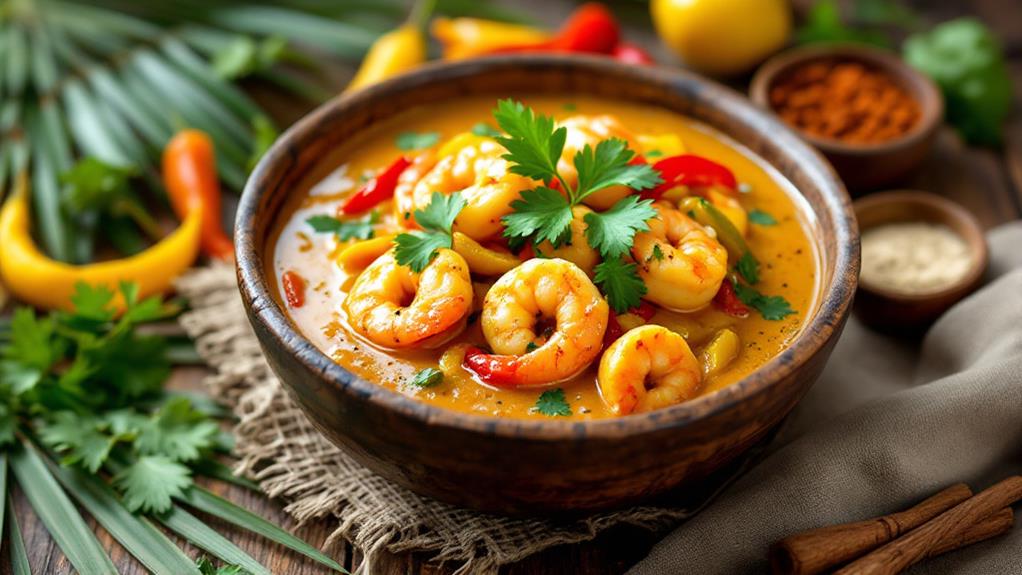You might not realize that coconut milk has been a staple in many tropical cuisines for centuries, prized not just for its flavor but also for its versatility. When you combine this creamy ingredient with succulent shrimp and a few aromatic spices, you create a dish that's both simple and elegant. The process is straightforward, yet the results can impress even the most discerning palate. Curious about how to achieve that perfect balance of flavors in your own kitchen?
Key Takeaways
- Start with fresh shrimp, clean and marinate with spices like turmeric, cumin, and coriander for enhanced flavor.
- Sauté chopped onions, garlic, and ginger in oil to create a rich aromatic base for the curry.
- Stir in coconut milk for a creamy texture that balances the spices and enhances the dish's richness.
- Season with salt, curry powder, lime juice, and fresh herbs for a well-rounded flavor profile.
- Serve with jasmine rice or naan, and consider pairing with dipping sauces for added variety.
Ingredients Needed
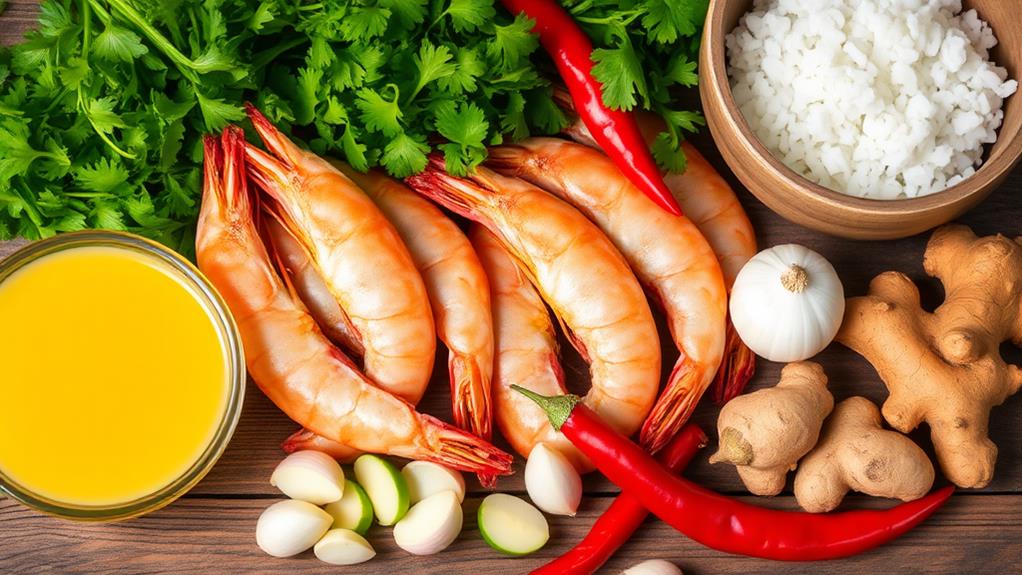
When you're ready to whip up a delicious Coconut Shrimp Curry, gathering the right ingredients is essential. Start with fresh shrimp, and consider exploring different shrimp varieties, like jumbo, tiger, or even wild-caught. Each type brings unique textures and flavors to your dish, enhancing the overall experience.
Next, you'll need coconut milk, which is the star ingredient in this recipe. Not only does it provide a creamy base, but it also boasts numerous coconut benefits, such as promoting heart health and improving digestion.
Don't forget a blend of aromatic spices—think turmeric, cumin, and coriander. These spices will elevate the curry's flavor profile, adding warmth and depth.
Fresh garlic and ginger are vital as well; they'll infuse your dish with vibrant zest.
Preparing the Shrimp
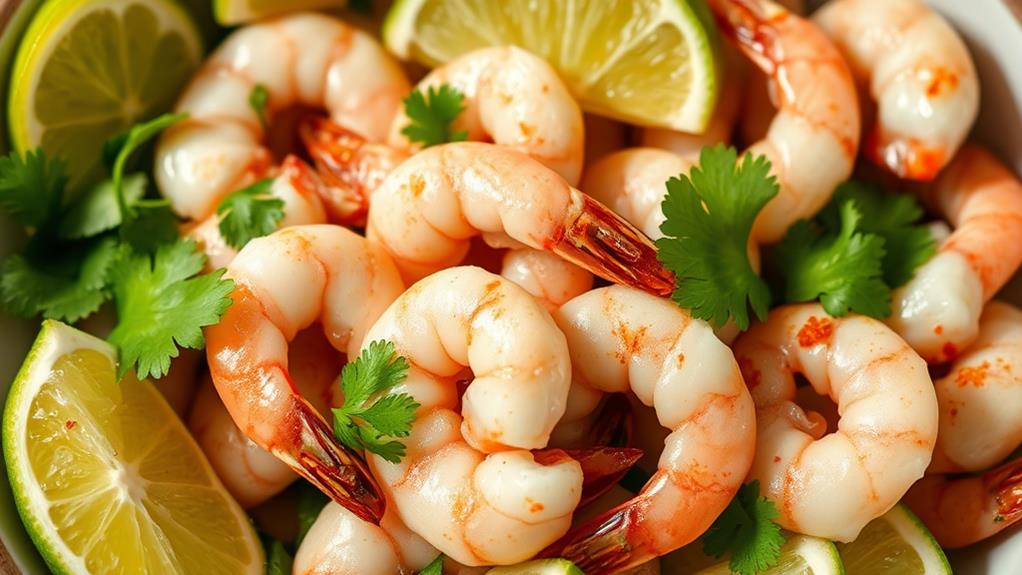
With your ingredients gathered, it's time to prepare the shrimp for your Coconut Shrimp Curry. First, focus on shrimp sourcing. If you can, choose fresh shrimp from a local market, or opt for high-quality frozen shrimp if fresh isn't available. Look for shrimp that's firm and has a mild ocean scent, avoiding any that smell overly fishy.
Next, once you've got your shrimp, it's essential to clean them properly. Rinse the shrimp under cold water, then peel and devein them if necessary.
Now, it's time for shrimp marinating. In a bowl, combine your choice of spices—like garlic, ginger, and a splash of lime juice—and toss the shrimp in this mixture. Let them marinate for at least 15-20 minutes. This step enhances the flavor, allowing the shrimp to absorb those delicious seasonings.
As you wait, you can prep other ingredients for the curry. When the shrimp are done marinating, they'll be ready to shine in your dish, infusing your Coconut Shrimp Curry with that savory taste you crave. Enjoy this moment of anticipation; the best is yet to come!
Cooking the Curry
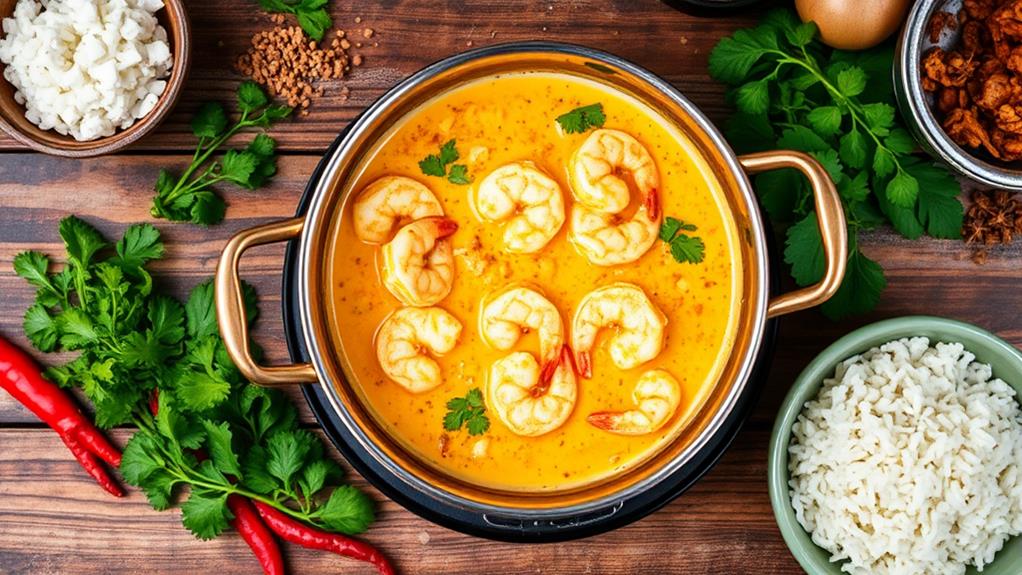
As you dive into cooking the curry, the aroma of spices will soon envelop your kitchen, setting the stage for a delightful meal. Start by heating a splash of oil in a large pan over medium heat. Add your chopped onions, letting them soften and turn golden. This cooking technique creates a rich base, enhancing the overall flavor.
Next, toss in minced garlic and ginger, stirring them for about a minute until fragrant. At this stage, you'll want to introduce your chosen spices—cumin, coriander, and a hint of turmeric. These spices not only add depth but also require careful flavor balancing. Adjust the quantities to match your palate, ensuring no single spice overwhelms the others.
Once the spices bloom, add your prepped vegetables, allowing them to sauté briefly. This technique helps to lock in their natural sweetness, providing a beautiful contrast to the spices. Stir occasionally, ensuring everything melds harmoniously.
As you cook, taste and adjust seasonings, guiding your dish toward that perfect balance. With every step, you're not just cooking; you're creating layers of flavor that will make your coconut shrimp curry unforgettable.
Adding Coconut Milk
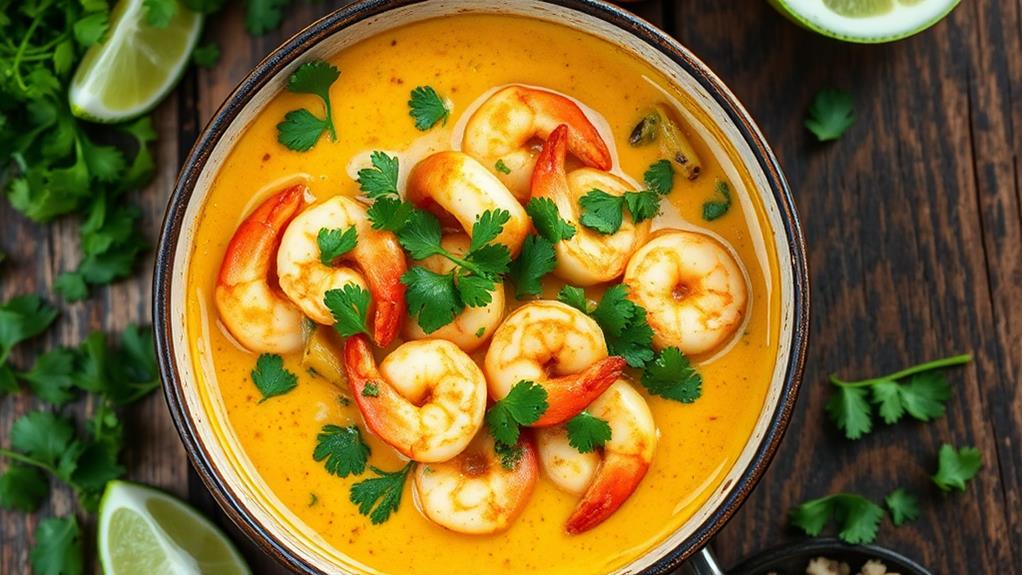
The creamy richness of coconut milk transforms your curry into a luscious delight that's hard to resist. When you add coconut milk, it not only brings a velvety texture but also infuses your dish with a subtle sweetness that beautifully balances the spices. As you stir it in, watch how the vibrant colors of your ingredients meld into a harmonious blend, creating a dish that's visually appealing and deeply flavorful.
Coconut milk is a fantastic choice for those seeking dairy-free or vegan options, making it one of the best milk alternatives available. It's rich in healthy fats, which can provide you with quick energy and support heart health, showcasing the coconut benefits you'll love.
Plus, its creamy consistency makes it an ideal base for curries, ensuring every bite is a mouthful of comfort. As you incorporate coconut milk into your curry, remember to adjust the quantity based on how rich and creamy you want your dish.
Whether you prefer a lighter sauce or a more indulgent experience, coconut milk gives you the flexibility to create your perfect curry. Enjoy the magic it brings to your culinary creation!
Seasoning to Taste
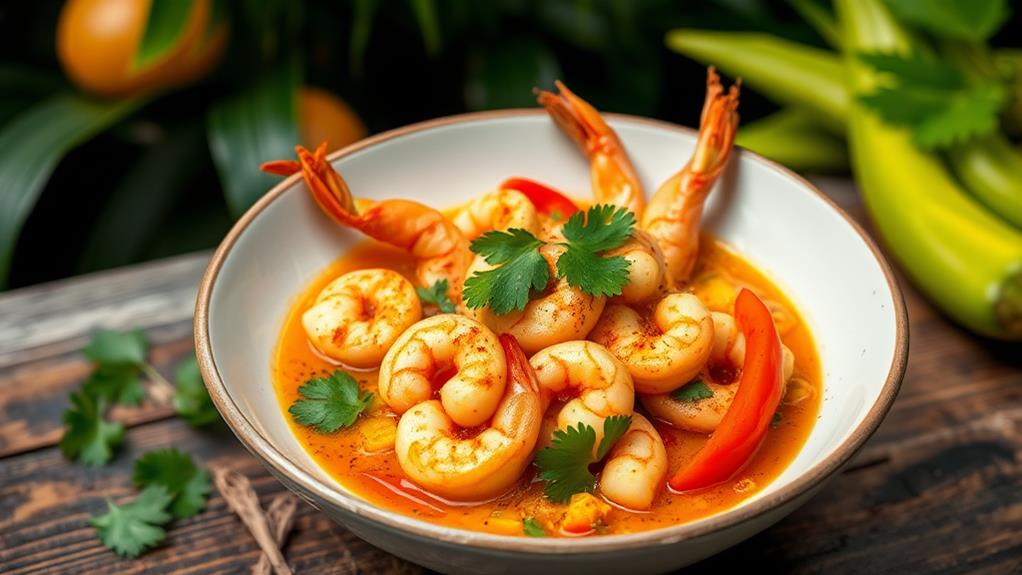
Seasoning your coconut shrimp curry is where the magic truly happens, transforming a good dish into something unforgettable. By carefully balancing spice combinations and flavor profiles, you'll create a symphony of tastes that dance on your palate. Here's how to elevate your curry:
- Salt: Enhances all the other flavors and brings them together.
- Curry Powder: A blend of spices that adds warmth and depth; adjust according to your heat preference.
- Lime Juice: A splash at the end brightens the dish and adds a refreshing zing.
- Fresh Herbs: Cilantro or basil can add a touch of green and enhance freshness.
As you season, remember to taste as you go. Start with small amounts; it's easier to add than to take away.
Consider how different spices interact; for example, combining turmeric with cumin can yield a rich, earthy flavor profile. If you love heat, don't shy away from adding a pinch of cayenne or red pepper flakes.
Ultimately, your coconut shrimp curry should reflect your personal taste, turning a simple meal into a memorable culinary experience. Enjoy the process!
Serving Suggestions
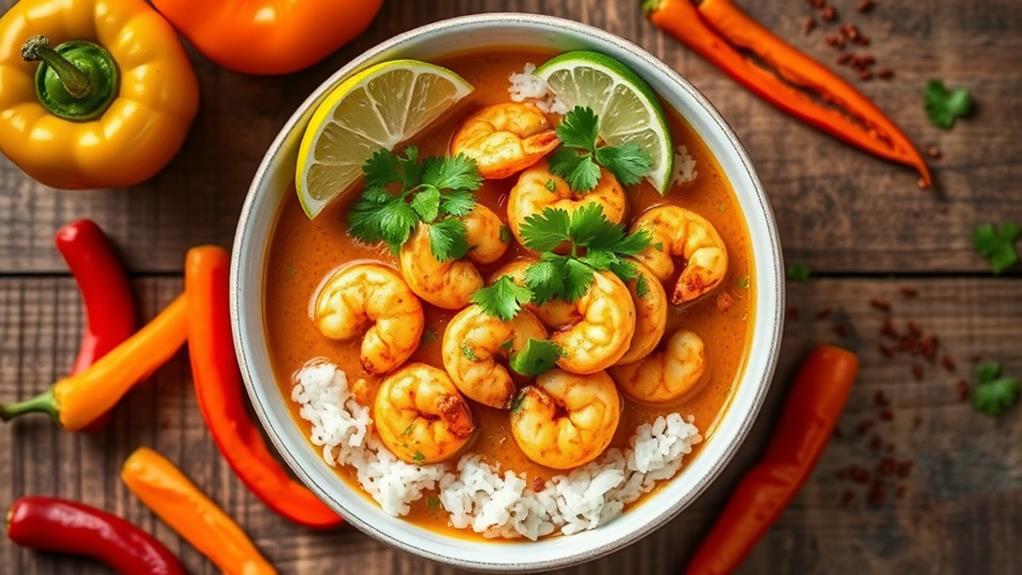
When it comes to serving your coconut shrimp curry, presentation can elevate the entire dining experience. Start by ladling the vibrant curry into a shallow bowl, allowing the rich colors to shine. Nestle the golden, crispy shrimp on top, their texture contrasting beautifully with the creamy sauce.
For an added touch, sprinkle fresh cilantro or chopped green onions over the dish, providing a pop of color and freshness.
Pair your curry with side dishes that complement its flavors. Jasmine rice is a classic choice, soaking up the delicious sauce while offering a fragrant base. You could also serve it with warm naan or steamed vegetables for a heartier meal.
Don't forget about dipping sauces! A tangy mango chutney or a cool yogurt sauce can enhance the experience, offering a delightful contrast to the warmth of the curry. Arrange these sauces in small bowls on the side, inviting your guests to mix and match as they please.
With these serving suggestions, you'll create a visually stunning and flavorful dish that will impress everyone at the table. Enjoy the delightful fusion of flavors!
Storing Leftovers
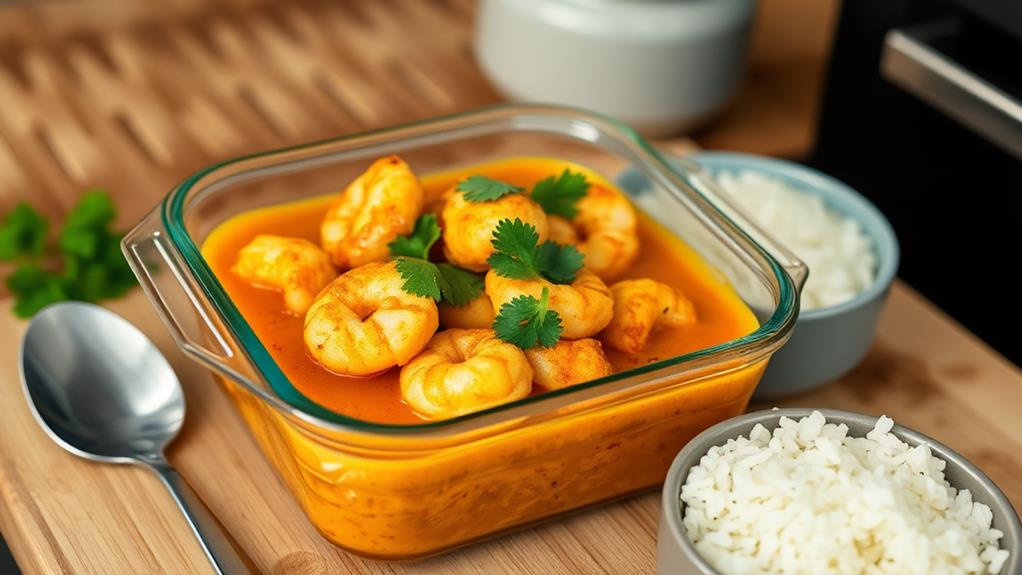
After savoring your delicious coconut shrimp curry, you might wonder how to best store any leftovers to maintain their tantalizing flavors. Proper storage is key to enjoying your dish later without compromising its taste and texture. Here are some helpful storage tips:
- Cool it down: Let the curry cool to room temperature before storing.
- Use airtight containers: Choose glass or plastic containers that seal tightly.
- Label and date: Write the date on the container, so you know when to use it.
- Refrigerate promptly: Store leftovers in the fridge within two hours to keep them fresh.
When it comes to leftover recipes, your coconut shrimp curry can still shine! You can reheat it gently on the stove or microwave, adding a splash of coconut milk if it thickens too much.
Additionally, consider using the leftovers in a flavorful wrap, or over rice for a quick lunch. By following these simple storage tips, you'll ensure your coconut shrimp curry remains as delicious as the first bite, ready for you to enjoy again soon!
Frequently Asked Questions
Can I Use Frozen Shrimp Instead of Fresh for This Recipe?
Yes, you can absolutely use frozen shrimp! Just make sure you thaw them properly, either overnight in the fridge or quickly under cold running water. Proper thawing ensures even cooking and enhances the dish's flavor.
What Type of Coconut Milk Is Best for Curry?
When choosing coconut milk for curry, opt for full-fat varieties for rich, creamy texture. Light coconut milk might dilute flavor profiles. Experiment with brands to enhance your dish's unique curry flavor, achieving delicious results every time.
Is This Curry Dish Spicy or Mild?
The spice level of this dish leans towards mild, allowing the rich, creamy flavor profile to shine. You'll enjoy a harmonious blend of spices that enhances the overall taste without overpowering your palate.
Can I Add Vegetables to the Curry?
Adding vegetables to the curry is like painting a vibrant canvas. You can mix in various vegetable combinations, enhancing flavor and boosting nutritional benefits, making your dish not only more colorful but also healthier and satisfying.
How Long Does It Take to Cook the Shrimp?
Cooking shrimp usually takes about 2 to 3 minutes per side, ensuring they're pink and opaque. For shrimp safety, avoid overcooking; it makes them tough. Keep an eye on them for the best results!
